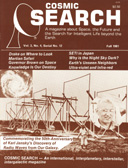![[NAAPO Logo]](../../Images/NAAPOsm.jpg) North American AstroPhysical Observatory (NAAPO)
|
|
In Review:
By: Robert H. Van Horn
The First Stargazers: An introduction to the Origins of Astronomy
Stonehenge, the Pyramids of Egypt and Central America — what images they conjure up of ancient priests and princes performing secret rites to guide and protect the destinies of the peoples. James Cornell in his new book, "The First Stargazers," gives us a comprehensive account of how the new science of archaeoastronomy is deciphering the old mysteries of Stonehenge, the Pyramids, and a host of other structures, artifacts, and relics by which pre-literate man related the movements of the sun, moon, and stars to his daily life. If you wonder about how man got started on astronomy and
the other sciences, "The First Stargazers" is for you.
Stonehenge, as many already know, was a primitive observatory. Its priests could predict the exact arrival of equinoxes and solstices. They could also predict eclipses by various sightings along lines joining selected stones. This provided early Britons with a precise calendar for planting, harvesting, or religious festivals. Similarly, the ancient Egyptians used pre-dawn sightings of the rise of the bright star, Sirius, to signal the summer solstice and the annual rise of the Nile. Cornell gives us a detailed history of how archaeologists and astronomers joined forces (not without much struggle) to arrive at a rational and coherent view of early man's astronomy.
Britons, Egyptians, and Central American Mayans were not the only pre-literate people to live by the sun, moon and stars. Cornell tells us how the people of Africa, Asia, Micronesia, and the Indians of North America have left us striking evidence of astronomical sophistication. For example, remnants from an Indian village at Cahokia, Illionois, are arranged in a circle and so oriented to the path of the sun that the site has been dubbed, "Woodhenge." "The First Stargazers" is rich with such examples.
In his Introduction, Cornell comments, "We still don't know if the observations of the stars, sun, and moon cycles led to an awareness of other natural phenomena, such as seasonal changes, animal migrations, and the growing habits of edible plants; or if just the reverse was true, and the observation of these natural and vital cycles led to a desire to predict them more accurately with a sky calendar. The intellectual development may not be as important as the simple awakening to the cyclic nature of life and the need for counting, measuring, and time-dating skills." But in astronomical awareness, there was a beginning.
In his final chapter, Cornell notes, "As we stand beneath a star-dappled sky and stare into space, we are linked in mind and spirit to those other watchers of the skies, who, in millenia long ago, gazed upon these same stars and perhaps asked the same questions."
What a pity it is that we are shutting ourselves off from those stars with city lights, smog, and perhaps worst of all, indifference. Can mankind retain the humanity it shares with these ancient ancestors if it blots out its view of those stars which led to its first steps upward?
Cornell has done us a favor by giving us this view of "The First Stargazers." For those who wish to dig deeper, there is an extensive bibliography.
The Quest for Extraterrestrial Life, A Book of Readings,
In "The Quest for Extraterrestriai Life," Donald Goldsmith gives us the texts of fifty eight original papers on the subject beginning with Lucretius,"On the Nature of Things," dated about 70 B.C. to the recent writings of Carl Sagan, Philip Morrison, Ronald Bracewell, Gerard O'Neill, and many others.
This is an excellent source book, fascinating for browsing, and useful for reference. It belongs on the shelf of any SETI devotee.
|
